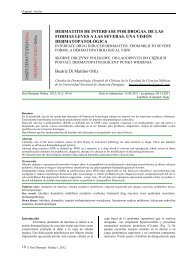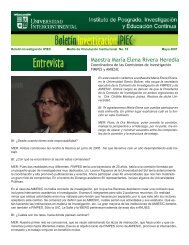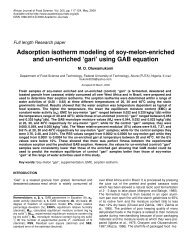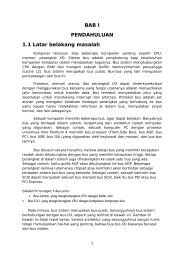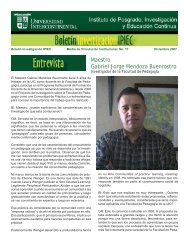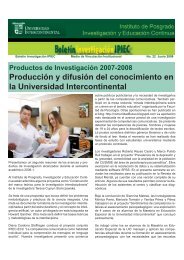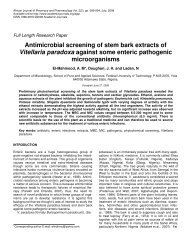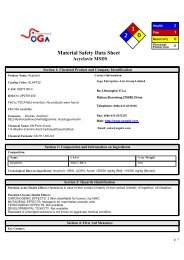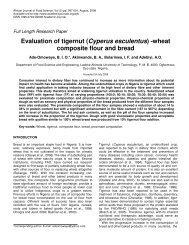Lacasses in the textile industry - Science Stage
Lacasses in the textile industry - Science Stage
Lacasses in the textile industry - Science Stage
Create successful ePaper yourself
Turn your PDF publications into a flip-book with our unique Google optimized e-Paper software.
Biotechnology and Molecular Biology Review Vol. 1 (4), pp. 117-122, December 2006<br />
Available onl<strong>in</strong>e at http://www.academicjournals.org/BMBR<br />
ISSN 1538-2273 © 2006 Academic Journals<br />
M<strong>in</strong>i Review<br />
<strong>Lacasses</strong> <strong>in</strong> <strong>the</strong> <strong>textile</strong> <strong>in</strong>dustry<br />
Susana Rodríguez Couto* and José Luis Toca-Herrera*<br />
Department of Chemical Eng<strong>in</strong>eer<strong>in</strong>g, Rovira i Virgili University. Av. Països Catalans 26, 43007 Tarragona, Spa<strong>in</strong>.<br />
Accepted 13 November, 2006<br />
The search for efficient and green oxidation technologies has <strong>in</strong>creased <strong>the</strong> <strong>in</strong>terest <strong>in</strong> <strong>the</strong> use of<br />
enzymes to replace <strong>the</strong> conventional non-biological methods. Among <strong>the</strong> different exist<strong>in</strong>g oxidant<br />
enzymes, laccases (benzenediol: oxygen oxidoreductases; EC 1.10.3.2) have been subject of <strong>in</strong>tensive<br />
research <strong>in</strong> <strong>the</strong> last decades due to <strong>the</strong>ir low substrate specificity. The use of laccases <strong>in</strong> <strong>the</strong> <strong>textile</strong><br />
<strong>in</strong>dustry is grow<strong>in</strong>g very fast, s<strong>in</strong>ce besides to decolourise <strong>textile</strong> effluents, laccases are used to bleach<br />
<strong>textile</strong>s, modify <strong>the</strong> surface of fabrics and syn<strong>the</strong>tise dyes. Therefore, laccase-based processes might<br />
replace <strong>the</strong> traditionally high chemical, energy and water-consum<strong>in</strong>g <strong>textile</strong> operations. The present<br />
paper offers an overview of <strong>the</strong> laccase applications <strong>in</strong> <strong>the</strong> <strong>textile</strong> <strong>in</strong>dustry up to date.<br />
Keywords: bleach<strong>in</strong>g, decolouration, denim, laccase, <strong>textile</strong> <strong>in</strong>dustry, wastewater<br />
Table of Contents<br />
1.0 Introduction<br />
2.0 Potential applications of laccases <strong>in</strong> <strong>the</strong> <strong>textile</strong> <strong>in</strong>dustry<br />
2.1 Wastewater treatment<br />
2.2 Denim f<strong>in</strong>ish<strong>in</strong>g<br />
2.3 Cotton bleach<strong>in</strong>g<br />
2.4 Rove Scour<strong>in</strong>g<br />
2.5 Wool dye<strong>in</strong>g<br />
2.6 Anti-shr<strong>in</strong>k treatment for wool<br />
2.7 Dye syn<strong>the</strong>sis<br />
3.0 Future outlook<br />
4.0 Acknowledgments<br />
5.0 References<br />
1.0 INTRODUCTION<br />
The search for efficient and green oxidation technologies<br />
has <strong>in</strong>creased <strong>the</strong> <strong>in</strong>terest <strong>in</strong> <strong>the</strong> use of enzymes to<br />
replace <strong>the</strong> conventional non-biological methods. Among<br />
<strong>the</strong> different exist<strong>in</strong>g oxidant enzymes, laccases (benzenediol:<br />
oxygen oxidoreductases; EC 1.10.3.2) have been<br />
subject of <strong>in</strong>tensive research <strong>in</strong> <strong>the</strong> last decades because<br />
<strong>the</strong>y have <strong>the</strong> follow<strong>in</strong>g properties: low substrate<br />
specificity, do not need <strong>the</strong> addition or syn<strong>the</strong>s is of a low<br />
molecular weight cofactor, as <strong>the</strong>ir cosubstrate – oxygen<br />
– is usually present <strong>in</strong> <strong>the</strong>ir environment, most laccases<br />
*Coresspond<strong>in</strong>g authors E-mails: susana.rodriguez@urv.cat;<br />
joseluis.toca@urv.cat. Phone: +34 977 55 9617; Fax: +34<br />
977 55 9667<br />
are extracellular enzymes, mak<strong>in</strong>g <strong>the</strong> purification procedures<br />
very easy, <strong>the</strong>y generally exhibit a considerable<br />
level of stability <strong>in</strong> <strong>the</strong> extracellular environment, <strong>the</strong><br />
<strong>in</strong>ducible expression of laccases <strong>in</strong> most fungal species<br />
also contributes to <strong>the</strong>ir easy applicability <strong>in</strong> biotechnological<br />
processes.<br />
Yoshida (1883) first described laccase <strong>in</strong> 1883 when he<br />
extracted it from <strong>the</strong> exudates of <strong>the</strong> Japanese lacquer<br />
tree Rhus vernicifera, from which <strong>the</strong> name laccase was<br />
derived and was characterised as a metal-conta<strong>in</strong><strong>in</strong>g<br />
oxidase by Bertrand (1895). This makes It one of <strong>the</strong><br />
oldest enzymes ever described. Laccases have also<br />
been detected <strong>in</strong> <strong>in</strong>sects (Sidjanski et al., 1997) and bacteria<br />
(Alexandre and Zhul<strong>in</strong>, 2000) but <strong>the</strong>y are especially<br />
abundant <strong>in</strong> white-rot fungi, which are <strong>the</strong> only micro-org-
118 Biotechnol. Mol. Biol. Rev.<br />
Table 1. Status of copper <strong>in</strong> fungal laccases (extracted from Claus 2003). Three types of copper have been dist<strong>in</strong>guished.<br />
Cu type<br />
Cu atoms/<br />
prote<strong>in</strong><br />
EPR signal Features Coord<strong>in</strong>ation Functions<br />
1 1 +<br />
Paramagnetic<br />
2 1 +<br />
Paramagnetic<br />
3 2 -<br />
Diamagnetic<br />
“Blue Cu 2+ ”, absorbance at<br />
610 nm (oxidation), redox<br />
potential +785 mV<br />
“Non-blue Cu 2+ ”(aff<strong>in</strong>ity to<br />
azide, fluoride, cyanide)<br />
Sp<strong>in</strong>-coupled Cu 2+ -Cu 2+ pair<br />
Absorbance at 330 nm<br />
(oxidation)<br />
2 His, 1 Cys, 1<br />
Leu<br />
Tr<strong>in</strong>uclear<br />
center<br />
Substrate oxidation<br />
(one-electron step)<br />
Reoxidation of type<br />
1 Cu 2+<br />
Stabilisation of an<br />
H 2O 2 <strong>in</strong>termediate<br />
8 His O 2 reduction by<br />
enzyme oxidation<br />
(four electron<br />
transfer)<br />
anisms able to degrade <strong>the</strong> whole wood components.<br />
Laccases catalyse one electron oxidation of a wide<br />
range of <strong>in</strong>organic and organic substances, coupled with<br />
electron reduction of oxygen to water (Xu 1996). The<br />
molecular mass of <strong>the</strong> monomer ranges from about 50 to<br />
100 kDa (Sjoblad and Bollag 1981; Dean and Eriksson<br />
1994; Thurston 1994). An important feature of fungal<br />
laccases is a covalently l<strong>in</strong>ked carbohydrate moiety (10–<br />
45%), which may contribute to <strong>the</strong> high stability of <strong>the</strong><br />
enzyme (Durán et al., 2002). For <strong>the</strong> catalytic activity, a<br />
m<strong>in</strong>imum of four copper atoms per active prote<strong>in</strong> unit is<br />
needed. The copper atoms differ <strong>in</strong> <strong>the</strong>ir light absorbance<br />
and electron-paramagnetic behaviour (Table 1).<br />
Laccases have relatively lower redox potential (450-<br />
800 mV) compared to those of lign<strong>in</strong>olytic peroxidases<br />
(>1 V), so it was <strong>in</strong>itially thought that laccases would only<br />
be able to oxidise phenolic substrates (Kersten et al.<br />
1990). However, <strong>the</strong> range of substrates oxidised by<br />
laccases can be <strong>in</strong>creased through a mediator-<strong>in</strong>volved<br />
reaction mechanism. Mediators are low molecular weight<br />
compounds that are easily oxidised by laccases<br />
produc<strong>in</strong>g, <strong>in</strong> some cases, very unstable and reactive<br />
cationic radicals, which can oxidise more complex<br />
substrates before return<strong>in</strong>g to <strong>the</strong>ir orig<strong>in</strong>al state. The<br />
electrons taken by laccases are f<strong>in</strong>ally transferred back to<br />
oxygen to form water (McGuirl and Dooley, 1999; Wong<br />
and Yu, 1999).<br />
The laccase mediator system (LMS) has yet to be<br />
applied on large scale due to <strong>the</strong> cost of mediators and<br />
<strong>the</strong> lack of studies that guarantee <strong>the</strong> absence of toxic<br />
effects of <strong>the</strong>se compounds or <strong>the</strong>ir derivatives. The use<br />
of naturally-occurr<strong>in</strong>g laccase mediators would present<br />
environmental and economic advantages. Recently,<br />
Camarero et al. (2005) reported that several lign<strong>in</strong>-derived<br />
phenols (such as syr<strong>in</strong>galdehyde and acetosyr<strong>in</strong>gone)<br />
represented ecofriendly alternatives to syn<strong>the</strong>tic<br />
mediators for <strong>the</strong> degradation of different types of dyes<br />
and o<strong>the</strong>r recalcitrant compounds by laccase <strong>in</strong> terms of<br />
both efficiency and velocity of oxidation. Figure 1 shows<br />
<strong>the</strong> structure of different syn<strong>the</strong>tic and natural mediators<br />
of laccases.<br />
The use of laccases <strong>in</strong> <strong>the</strong> <strong>textile</strong> <strong>in</strong>dustry is grow<strong>in</strong>g<br />
very fast, s<strong>in</strong>ce besides to decolourise <strong>textile</strong> effluents,<br />
laccases are used to bleach <strong>textile</strong>s (V<strong>in</strong>od 2001),<br />
syn<strong>the</strong>tise dyes (Setti et al. 1999) and modify <strong>the</strong> surface<br />
of fabrics (Zille 2005). The first commercial use of<br />
laccases <strong>in</strong> <strong>the</strong> <strong>textile</strong> <strong>in</strong>dustry was <strong>in</strong> <strong>the</strong> denim-wash<strong>in</strong>g<br />
process, where LMS was used to reduce backsta<strong>in</strong><strong>in</strong>g,<br />
enhance abrasion levels and bleach <strong>in</strong>digo.<br />
2.0 Potential applications of laccases <strong>in</strong> <strong>the</strong><br />
<strong>textile</strong> <strong>in</strong>dustry<br />
2.1 Wastewater treatment<br />
The pollution problems due to <strong>the</strong> <strong>textile</strong> <strong>in</strong>dustry<br />
effluents have <strong>in</strong>creased <strong>in</strong> <strong>the</strong> last years. The dye<strong>in</strong>g<br />
processes have, <strong>in</strong> general, a low yield and <strong>the</strong><br />
percentage of <strong>the</strong> lost dye <strong>in</strong> <strong>the</strong> effluents can reach up to<br />
50% (Pierce, 1994; Pearce et al., 2003). From <strong>the</strong><br />
available literature it can be estimated that approximately<br />
75% of <strong>the</strong> dyes, discharged by Western European <strong>textile</strong><br />
process<strong>in</strong>g <strong>in</strong>dustries, belong to <strong>the</strong> follow<strong>in</strong>g classes:<br />
reactive (~36%), acid (~25%) and direct (~15%) (Øllgaard<br />
et al., 1998). In <strong>the</strong>se classes, <strong>the</strong> azo dyes are <strong>the</strong> most<br />
important chemical class of syn<strong>the</strong>tic dyes. Azo dyes are<br />
characterised by <strong>the</strong> presence of at least one azo bond (-<br />
N=N-) bear<strong>in</strong>g aromatic r<strong>in</strong>gs and have high photolytic<br />
stability and resistance towards major oxidis<strong>in</strong>g agents<br />
Reife et al. (1993).<br />
Textile dye effluents are complex, conta<strong>in</strong><strong>in</strong>g a wide<br />
variety of dyes, natural impurities extracted from <strong>the</strong><br />
fibers and o<strong>the</strong>r products such as dispersants, levell<strong>in</strong>g<br />
agents, acids, alkalis, salts and some times heavy metals<br />
(La<strong>in</strong>g, 1991). In general, <strong>the</strong> effluent is highly coloured<br />
with high biological oxygen demand (BOD) and chemical<br />
oxygen demand (COD), it has a high conductivity and is<br />
alkal<strong>in</strong>e <strong>in</strong> nature. The degradation products of <strong>textile</strong><br />
dyes are often carc<strong>in</strong>ogenic (Das et al., 1995; Banat et
Couto and Toca-Herrera 119<br />
Figure 1. Chemical structures of natural (a to j) and syn<strong>the</strong>tic mediators (k to r). (a) Acetosyr<strong>in</strong>gone;<br />
(b) syr<strong>in</strong>galdehyde; (c) 2,6-dimethylphenol; (d) 2,4,6-trimethoxyphenol; (e) ethyl vanill<strong>in</strong>; (f)<br />
acetovanillone; (g) vanill<strong>in</strong>; (h) vanillyl alcohol; (i) methyl vanillate; (j) p-coumaric acid; (k) ABTS (2,2-<br />
az<strong>in</strong>obis-(3-ethylbenzothiazol<strong>in</strong>e-6-sulfonic acid)); (l) HBT (1-hydroxybenzotriazole); (m) VIO (violuric<br />
acid); (n) TEMPO (2,2,6,6-tetramethylpiperid<strong>in</strong>-1-yloxy); (o) HNNS (2-nitroso-1-naphthol-4-sulfonic<br />
acid); (p) NNDS (1-nitroso-2-naphthol-3,6-disulfonic acid); (q) PZ (promaz<strong>in</strong>e) (extracted from<br />
Camarero et al. 2005).<br />
al., 1996). Fur<strong>the</strong>rmore, <strong>the</strong> absorption of light due to<br />
<strong>textile</strong> dyes creates problems to photosyn<strong>the</strong>tic aquatic<br />
plants and algae.<br />
Most currently exist<strong>in</strong>g processes to treat dye<br />
wastewater are <strong>in</strong>effective and not economical (Cooper,<br />
1995; Stephen, 1995). Therefore, <strong>the</strong> development of<br />
processes based on laccases seems an attractive solution<br />
due to <strong>the</strong>ir potential <strong>in</strong> degrad<strong>in</strong>g dyes of diverse<br />
chemical structure (Abadulla et al., 2000; Blá-nquez et<br />
al., 2004; Hou et al., 2004; Salony and Bisaria, 2006),<br />
<strong>in</strong>clud<strong>in</strong>g syn<strong>the</strong>tic dyes currently employed <strong>in</strong> <strong>the</strong><br />
<strong>in</strong>dustry (Rodríguez Couto et al., 2004; Ro-dríguez Couto
120 Biotechnol. Mol. Biol. Rev.<br />
et al., 2005).<br />
2.2 Denim f<strong>in</strong>ish<strong>in</strong>g<br />
In <strong>the</strong> <strong>textile</strong> f<strong>in</strong>ish<strong>in</strong>g <strong>in</strong>dustry, enzymatic degradation of<br />
<strong>in</strong>digo could have a potential both <strong>in</strong> stone-wash process<br />
and for <strong>the</strong> treatment of dye<strong>in</strong>g effluents. Several steps<br />
are <strong>in</strong>volved <strong>in</strong> <strong>the</strong> manufacture of denim garments between<br />
dye<strong>in</strong>g and <strong>the</strong> f<strong>in</strong>al stone-wash<strong>in</strong>g where excessive<br />
amounts of <strong>in</strong>digo are removed from <strong>the</strong> fabrics and<br />
discharged with <strong>the</strong> wastewater. The traditional technology<br />
of produc<strong>in</strong>g a stone-washed look <strong>in</strong> denim fabric<br />
<strong>in</strong>volves <strong>the</strong> wash of <strong>the</strong> fabrics <strong>in</strong> <strong>the</strong> presence of<br />
pumice to generate <strong>the</strong> desired erosion of <strong>the</strong> fabrics.<br />
Subsequently, <strong>the</strong> fabrics are partially blea-ched by a<br />
treatment with sodium hypochlorite, followed by neutralisation<br />
and a r<strong>in</strong>s<strong>in</strong>g step all caus<strong>in</strong>g substantial environmental<br />
pollution (Pedersen and Schneider 1998).<br />
In 1996, Novozyme (Novo Nordisk, Denmark) launched<br />
a new <strong>in</strong>dustrial application of laccase enzyme <strong>in</strong> denim<br />
f<strong>in</strong>ish<strong>in</strong>g: DeniLite TM , <strong>the</strong> first <strong>in</strong>dustrial laccase and <strong>the</strong><br />
first bleach<strong>in</strong>g enzyme act<strong>in</strong>g with <strong>the</strong> help of a mediator<br />
molecule. In 1999, USA launched DeniLiteII TM based on a<br />
new type of laccase with higher activity than that of<br />
DeniliteI TM . Also, <strong>in</strong> 2001, <strong>the</strong> company Zytex (Zytex Pvt.<br />
Ltd., Mumbai, India) developed a formulation based on<br />
LMS capable of degrad<strong>in</strong>g <strong>in</strong>digo <strong>in</strong> a very specific way.<br />
The trade name of <strong>the</strong> product is Zylite.<br />
Campos et al. (2001) reported <strong>the</strong> degradation of <strong>in</strong>digo<br />
both <strong>in</strong> effluents and on fabrics us<strong>in</strong>g purified laccases<br />
from Trametes hirsuta and Sclerotium rolfsii <strong>in</strong> comb<strong>in</strong>ation<br />
with redox-mediators and reported that bleach<strong>in</strong>g<br />
of fabrics by <strong>the</strong> laccases correlated with <strong>the</strong> release of<br />
<strong>in</strong>digo degradation products. More recently, Pazarlogliu<br />
et al. (2005) showed that a phenol-<strong>in</strong>duced laccase from<br />
Trametes versicolor was an effective agent for stonewash<strong>in</strong>g<br />
effects of denim fabric without us<strong>in</strong>g a mediator.<br />
Moreover, <strong>the</strong>y found that T. versicolor laccase without a<br />
mediator was more effective than commercial laccase<br />
(obta<strong>in</strong>ed from recomb<strong>in</strong>ant Aspergillus niger, Novo<br />
Nordisk, Denmark) with a mediator.<br />
2.3 Cotton bleach<strong>in</strong>g<br />
The purpose of cotton bleach<strong>in</strong>g is to decolourise natural<br />
pigments and to confer a pure white appearance to <strong>the</strong><br />
fibres. Ma<strong>in</strong>ly flavonoids are responsible for <strong>the</strong> colour of<br />
cotton (Hed<strong>in</strong> et al., 1992; Ardon et al., 1996). The most<br />
common <strong>in</strong>dustrial bleach<strong>in</strong>g agent is hydrogen peroxide,<br />
which is usually applied at alkal<strong>in</strong>e pH and temperatures<br />
close to boil<strong>in</strong>g. However, radical reactions of bleach<strong>in</strong>g<br />
agents with <strong>the</strong> fibre can lead to a decrease <strong>in</strong> <strong>the</strong> degree<br />
of polymerisation and, thus, to severe damage. Fur<strong>the</strong>rmore,<br />
a huge amount of water is needed to remove<br />
hydrogen peroxide from fabrics, which can cause problems<br />
<strong>in</strong> dye<strong>in</strong>g. Therefore, replacement of hydrogen peroxide<br />
by an enzymatic bleach<strong>in</strong>g system would not only<br />
lead to better product quality due to less fibre damage but<br />
also to substantial sav<strong>in</strong>gs on wash<strong>in</strong>g water needed for<br />
<strong>the</strong> removal of hydrogen peroxide.<br />
Tzanov et al. (2003a) reported for <strong>the</strong> first time <strong>the</strong><br />
enhancement of <strong>the</strong> bleach<strong>in</strong>g effect achieved on cotton<br />
fabrics us<strong>in</strong>g laccases <strong>in</strong> low concentrations. In addition,<br />
<strong>the</strong> short time of <strong>the</strong> enzymatic pre-treatment sufficient to<br />
enhance fabric whiteness makes this bio-process suitable<br />
for cont<strong>in</strong>uous operations. Also, Pererira et al. (2005)<br />
showed that a laccase from a newly isolated stra<strong>in</strong> of T.<br />
hirsuta was responsible for whiteness improvement of<br />
cotton most likely due to oxidation of flavonoids. More<br />
recently, Basto et al. (2006) proposed a comb<strong>in</strong>ed<br />
ultrasound-laccase treatment for cotton bleach<strong>in</strong>g. They<br />
found that <strong>the</strong> supply of low ultrasound energy (7 W)<br />
enhanced <strong>the</strong> bleach<strong>in</strong>g efficiency of laccase on cotton<br />
fabrics.<br />
2.4 Rove scour<strong>in</strong>g<br />
Flax process<strong>in</strong>g <strong>in</strong>to yarn essentially still follows traditional<br />
methodologies. As an alternative to <strong>the</strong> chemical<br />
scour<strong>in</strong>g of rove, Ossola and Galante, (2004) studied <strong>the</strong><br />
effects of several enzymes under slightly alkal<strong>in</strong>e pH<br />
conditions. They found that <strong>the</strong> treatment with laccase<br />
plus mediator performed better than <strong>the</strong> chemical one.<br />
Also, Sharma et al. (2005) showed that laccase enzyme<br />
could be used for rov<strong>in</strong>g treatment to improve yarn<br />
regularity. The advantage of <strong>the</strong> use of laccase <strong>in</strong> rove<br />
scour<strong>in</strong>g is that <strong>the</strong> process is performed under mild<br />
reaction conditions result<strong>in</strong>g, thus, <strong>in</strong> an ecologicallyfriendly<br />
process.<br />
2.5 Wool dye<strong>in</strong>g<br />
Sh<strong>in</strong> et al. (2001) showed that laccase was able to colour<br />
wool fabric that was previously padded with hydroqu<strong>in</strong>one.<br />
More recently, Tzanov et al. (2003b) and Zille<br />
(2005) also proved <strong>the</strong> ability of laccases for wool dye<strong>in</strong>g.<br />
They used a dye bath prepared with a dye precursor (2,5-<br />
diam<strong>in</strong>obenzenesulfonic acid), dye mo-difiers (catechol<br />
and resorc<strong>in</strong>ol) and laccase, without any dye<strong>in</strong>g auxiliaries.<br />
Additionally, <strong>the</strong> enzymatic reaction was carried out<br />
at pH and temperature values safe to <strong>the</strong> wool material.<br />
Fur<strong>the</strong>rmore, <strong>the</strong>y showed that by pro-long<strong>in</strong>g <strong>the</strong> contact<br />
time between wool, enzyme, precursor and modifier<br />
deeper colours were obta<strong>in</strong>ed <strong>in</strong> contrast to <strong>the</strong> conventional<br />
procees <strong>in</strong> which deeper colours are atta<strong>in</strong>ed by<br />
<strong>in</strong>creas<strong>in</strong>g <strong>the</strong> amount of dye. This makes wool dye<strong>in</strong>g<br />
with laccase an economically attractive alternative to <strong>the</strong><br />
conventional process, which uses high amounts of water,<br />
auxiliaries, acid and energy. This laccase application is a<br />
promis<strong>in</strong>g technology esp-ecially for <strong>the</strong> coat<strong>in</strong>g of natural<br />
and syn<strong>the</strong>tic materials.<br />
2.6 Anti-shr<strong>in</strong>k treatment for wool<br />
A process conventionally used for wool shr<strong>in</strong>k-proof<strong>in</strong>g is<br />
chlor<strong>in</strong>ation. This process degrades <strong>the</strong> exo-cuticle of <strong>the</strong>
Couto and Toca-Herrera 121<br />
wool, form<strong>in</strong>g cysteic acid residues and prote<strong>in</strong> losses.<br />
This process has been replaced by prote<strong>in</strong>ases treatment<br />
due to <strong>the</strong>ir high specificity and much lower<br />
environmental impact. However, prote<strong>in</strong>ase treatment<br />
leads to prote<strong>in</strong> degradation, result<strong>in</strong>g <strong>in</strong> deterioration of<br />
fiber strength and limited shr<strong>in</strong>k resistance (Breier 2000;<br />
Breier 2002). A patent application about <strong>the</strong> use of<br />
laccase from T. versicolor plus a mediator to <strong>in</strong>crease <strong>the</strong><br />
shr<strong>in</strong>k resistance of wool was published (Yoon 1998).<br />
Also, Lantto et al. (2004) found that wool fibers can be<br />
activated with laccase if a suitable mediator is present.<br />
Therefore, <strong>the</strong> use of laccase for anti-shr<strong>in</strong>k treatment of<br />
wool seems very attractive.<br />
2.7 Dye syn<strong>the</strong>sis<br />
Setti et al. (1999) described <strong>the</strong> ability and efficacy of<br />
laccases from Pyricularia oryzae to form red azo dyes by<br />
<strong>the</strong> oxidative coupl<strong>in</strong>g of 3-methyl-2-benzothiazol<strong>in</strong>one<br />
hydrazone (MBTH) and phenols. More recently, Mustafa<br />
et al. (2005) showed that <strong>the</strong> oxidation of ferulic acid by<br />
laccase <strong>in</strong> a biphasic hydro-organic medium led to <strong>the</strong><br />
production of stable yellow coloured products, which<br />
were only soluble <strong>in</strong> <strong>the</strong> organic phase be<strong>in</strong>g, thus, easily<br />
recovered. The syn<strong>the</strong>sis of colourants by laccase <strong>in</strong> this<br />
medium is currently extended to o<strong>the</strong>r phenolic and<br />
polyphenolic compounds.<br />
3.0 Future outlook<br />
Laccases are promis<strong>in</strong>g enzymes to replace <strong>the</strong><br />
conventional chemical processes of <strong>the</strong> <strong>textile</strong> <strong>in</strong>dustry.<br />
However, one of <strong>the</strong> problems to commercialise <strong>the</strong> use<br />
of lacasse is <strong>the</strong> lack of sufficient enzyme stocks. Thus,<br />
efforts have to be made <strong>in</strong> order to achieve cheap<br />
overproduction of laccase <strong>in</strong> heterologous hosts and also<br />
<strong>the</strong>ir modification by chemical means or prote<strong>in</strong><br />
eng<strong>in</strong>eer<strong>in</strong>g to obta<strong>in</strong> more robust and active enzymes.<br />
Ano<strong>the</strong>r additional problem is <strong>the</strong> cost and toxicity of<br />
redox mediators. Fur<strong>the</strong>r <strong>in</strong>vestigations should consider<br />
different and less pollut<strong>in</strong>g mediators such as <strong>the</strong> natural<br />
mediators produced by laccase <strong>in</strong> a bio-environment<br />
dur<strong>in</strong>g lign<strong>in</strong> degradation.<br />
4.0 Acknowledgments<br />
SRC and JLTH are Ramón y Cajal Senior Research Fellows.<br />
The authors thank <strong>the</strong> Spanish M<strong>in</strong>istry of Education<br />
and <strong>Science</strong> for promot<strong>in</strong>g <strong>the</strong> Ramón y Cajal<br />
Programme.<br />
5.0 REFERENCES<br />
Abadulla E, Tzanov T, Costa S, Robra K-H, Cavaco-Paulo A, Gübitz<br />
GM (2000). Decolorization and detoxification of <strong>textile</strong> dyes with a<br />
laccase from Trametes hirsuta. Appl. Environ. Microb. 66: 3357-3362.<br />
Alexandre G, Zhul<strong>in</strong> IB (2000). Laccases are widespread <strong>in</strong> bacteria.<br />
Trends Biotechnol. 18: 41-42.<br />
Ardon O, Kerem Z, Hadar Y (1996). Enhancement of laccase activity <strong>in</strong><br />
liquid cultures of <strong>the</strong> lign<strong>in</strong>olytic fungus Pleurotus ostreatus by cotton<br />
stalk extract. J. Biotechnol. 51: 201-207.<br />
Banat IM, Nigam P, S<strong>in</strong>gh D, Marchant R (1996). Microbial<br />
decolorization of <strong>textile</strong>-dye-conta<strong>in</strong><strong>in</strong>g effluents: a review.<br />
Bioresource Technol. 58: 217-227.<br />
Basto C, Tzanov T, Cavaco-Paulo A (2006). Comb<strong>in</strong>ed ultrasoundlaccase<br />
assisted bleach<strong>in</strong>g of cotton Ultrason. Sonochem. In Press.<br />
Bertrand G (1895). Sur la laccase et sur le pouvoir oxydant de cette<br />
diastase. CR Acad. Sci. Paris 120: 266-269.<br />
Blánquez P, Casas N, Font X, Gabarrell M, Sarrá M, Cam<strong>in</strong>al G, Vicent<br />
T (2004). Mechanism of <strong>textile</strong> metal dye biotransformation by<br />
Trametes versicolor. Water Res. 38: 2166-2172.<br />
Breier R (2000). Lanazym-Re<strong>in</strong> Enzymatisce Antifilzausrüstung von<br />
Wolle von der Idee zur erfolgreichen Umsetzung <strong>in</strong> die Praxis. DWI<br />
Rep. 123: 49-62.<br />
Breier R (2002). Enzymatische Antifilzausrüstung von Wolle.<br />
Textilveredlung 36: 5-10.<br />
Camarero S, Ibarra D, Martínez MJ, Martínez AT (2005). Lign<strong>in</strong>-derived<br />
compounds as efficient laccase mediators for decolorization of<br />
different types of recalcitrant dyes. Appl. Environ. Microb. 71: 1775-<br />
1784.<br />
Campos R, Kandelbauer A, Robra KH, Cavaco-Paulo A, Gübitz GM<br />
(2001). Indigo degradation with purified laccases from Trametes<br />
hirsuta and Sclerotium rolfsii J. Biotechnol. 89:131-139.<br />
Claus H (2003). Laccases and <strong>the</strong>ir occurrence <strong>in</strong> prokaryotes. Arch.<br />
Microbiol. 179:145-150.<br />
Cooper P (1995). Remov<strong>in</strong>g colour from dye house wastewater. Asian<br />
Textile Journal 3: 52-56.<br />
Das SS, Dey S, Bhattacharyya BC (1995). Dye decolorization <strong>in</strong> a<br />
column bioreactor us<strong>in</strong>g wood-degrad<strong>in</strong>g fungus Phanerochaete<br />
chrysosporium. Indian Chem. Eng. Sect. A 37: 176-180.<br />
Dean JFD, Eriksson KEL (1994). Laccase and <strong>the</strong> deposition of lign<strong>in</strong> <strong>in</strong><br />
vascular plants. Holzforschung 48: 21-33.<br />
Durán N, Rosa MA, D’Annibale A, Gianfreda L (2002). Applications of<br />
laccases and tyros<strong>in</strong>ases (phenoloxidases) immobilized on different<br />
supports: a review. Enzyme Microb. Tech. 31: 907-931.<br />
Hed<strong>in</strong> PA, Jenkis JN, Parrot WL (1992). Evaluation of flavonoids <strong>in</strong><br />
Gossypium arboretum (L.) cottons as potential source of resistance<br />
to tobacco budworm. J. Chem. Ecol. 18:105-114.<br />
Hou H, Zhou J, J<strong>in</strong>g Cuihong Du W, Yan B (2004). Enhancement of<br />
laccase production by Pleurotus ostreatus and its use for <strong>the</strong><br />
decolorization of anthraqu<strong>in</strong>one dye. Process Biochem. 39: 1415–<br />
1419.<br />
Kersten PJ, Kalyanaraman B, Hammel KE, Re<strong>in</strong>hammar B, Kirk TK<br />
(1990). Comparison of lign<strong>in</strong> peroxidase, horseradish peroxidase and<br />
laccase <strong>in</strong> <strong>the</strong> oxidation of methoxybenzenes. Biochem. J. 268: 475-<br />
480.<br />
La<strong>in</strong>g IG (1991). The Impact of Effluent Regulations on <strong>the</strong> Dye<strong>in</strong>g<br />
Industry. Ver. Progr. Col. 12: 56-70.<br />
Lantto R, Schänberg C, Buchert J (2004). Effects of laccase-mediator<br />
comb<strong>in</strong>ation on wool. Textile Res. J. 74: 713-717.<br />
McGuirl MA, Dooley DM (1999). Copper-conta<strong>in</strong><strong>in</strong>g oxidases. Curr.<br />
Op<strong>in</strong>. Chem. Biol. 3: 138-134.<br />
Mustafa R, Muniglia L, Rovel B, Girard<strong>in</strong> M (2005). Phenolic colorants<br />
obta<strong>in</strong>ed by enzymatic syn<strong>the</strong>sis us<strong>in</strong>g a fungal laccase <strong>in</strong> a hydroorganic<br />
biphasic system. Food Res. Int. 38: 995-1000.<br />
Øllgaard H, Frost L, Galster J, Hansen OC (1998). Survey of azocolorants<br />
<strong>in</strong> Denmark: Consumption, use, health and environmental<br />
aspects. M<strong>in</strong>istry of Environment and Energy, Denmark.<br />
Ossola M, Galante YM (2004). Scour<strong>in</strong>g of flax rove with <strong>the</strong> aid of<br />
enzymes. Enzyme Microb. Tech. 34: 177-186.<br />
Pazarlıoglu NK, Sariiik M, Telefoncu A (2005). Laccase: production by<br />
Trametes versicolor and application to denim wash<strong>in</strong>g. Process<br />
Biochem. 40: 1673-1678.<br />
Pearce CI, Lloyd JR, Guthrie JT (2003). The removal of colour from<br />
<strong>textile</strong> wastewater us<strong>in</strong>g whole bacterial cells: a review. Dyes<br />
Pigments 58:179-196.<br />
Pedersen AH, Schneider P.t.N.N. (1998). US Pat. 5795855 A. US-<br />
Patent.<br />
Pereira L, Bastos C, Tzanov T, Cavaco-Paulo A, Gübitz GM (2005).<br />
Environmentally friendly bleach<strong>in</strong>g of cotton us<strong>in</strong>g laccases. Environ.
122 Biotechnol. Mol. Biol. Rev.<br />
Chem. Lett. 3: 66-69.<br />
Pierce J (1994). Colour <strong>in</strong> <strong>textile</strong> effluents - <strong>the</strong> orig<strong>in</strong>s of <strong>the</strong> problem. J.<br />
Soc. Dyers Colour. 110:131-134.<br />
Reife A, Othmer K, (1993). Kirk-Othmer Encyclopedia of Chemical<br />
Technology, John Wiley and Sons Inc., New York, pp. 753-784.<br />
Rodríguez Couto S, Hofer D, Sanromán MA, Gübitz GM (2004).<br />
Production of laccase by Trametes hirsuta grown <strong>in</strong> an immersion<br />
bioreactor. Application to decolourisation of dyes from a lea<strong>the</strong>r<br />
factory. Eng<strong>in</strong>eer<strong>in</strong>g <strong>in</strong> Life <strong>Science</strong>s 4: 233-238.<br />
Rodríguez Couto S, Sanromán MA, Gübitz GM (2005). Influence of<br />
redox mediators and metal ions on syn<strong>the</strong>tic acid dye decolourization<br />
by crude laccase from Trametes hirsuta. Chemosphere 58: 417-422.<br />
Salony SM, Bisaria VM (2006). Production and characterization of<br />
laccase from Cyathus bulleri and its use <strong>in</strong> decolourization of<br />
recalcitrant <strong>textile</strong> dyes. Appl. Microbiol. Biotechnol. 71: 646–653.<br />
Setti L, Giuliani S, Sp<strong>in</strong>ozzi G, Pifferi PG (1999). Laccase catalyzedoxidative<br />
coupl<strong>in</strong>g of 3-methyl 2-benzothiazol<strong>in</strong>one hydrazone and<br />
methoxyphenols. Enzyme Microb. Tech. 25: 285-289.<br />
Sharma HSS, Whiteside L, Kernaghan K (2005). Enzymatic treatment<br />
of flax fibre at <strong>the</strong> rov<strong>in</strong>g stage for production of wet-spun yarn.<br />
Enzyme Microb. Tech. 37: 386-394.<br />
Sh<strong>in</strong> H, Gübitz G, Cavaco-Paulo, A (2001). In Situ Enzymatically<br />
Prepared Polymers for Wool Coloration. Macromol. Mater. Eng. 286:<br />
691-694.<br />
Sidjanski S, Ma<strong>the</strong>ws GV, Vanderberg JP (1997). Electrophoretic<br />
separation and identification of phenol oxidases <strong>in</strong> hemolymph and<br />
midgut of adult Anopheles stephensi mosquitoes. J. Parasitol. 83:<br />
686-691.<br />
Sjoblad RD, Bollag JM (1981). Oxidative coupl<strong>in</strong>g of aromatic<br />
compounds by enzymes from soil microorganisms. In EA Paul, JN<br />
Ladd (eds) Soil biochemistry, Marcel Dekker, New York, pp 113-152.<br />
Stephen JA (1995). Electrooxidation of dyestuffs <strong>in</strong> waste waters. J.<br />
Chem. Technol. Biot. 62: 111-117.<br />
Thurston CF (1994). The structure and function of fungal laccase.<br />
Microbiology 140: 19-26.<br />
Tzanov T, Basto C, Gübitz GM, Cavaco-Paulo A (2003a). Laccases to<br />
Improve <strong>the</strong> Whiteness <strong>in</strong> a Conventional Bleach<strong>in</strong>g of Cotton.<br />
Macromol. Mater. Eng. 288: 807-810.<br />
Tzanov T, Silva CJ, Zille A, Oliveira J, Cavaco-Paulo A. (2003b). Effect<br />
of Some Process Parameters <strong>in</strong> Enzymatic Dye<strong>in</strong>g of Wool. Appl.<br />
Biochem. Biotech. 111:1-14.<br />
V<strong>in</strong>od S (2001) Enzymatic decolourisation of denims: A novel approach.<br />
Colourage 48: 25-26.<br />
Wong Y, Yu J (1999). Laccase-catalyzed decolorization of syn<strong>the</strong>tic<br />
dyes. Water Res. 33: 3512-3520.<br />
Xu F (1996). Oxidation of Phenols, Anil<strong>in</strong>es, and Benzenethiols by<br />
Fungal Laccases: Correlation between Activity and Redox Potentials<br />
as Well as Halide Inhibition. Biochemistry-US 35: 7608-7614.<br />
Yoon MY (1998). Process for improved shr<strong>in</strong>k resistance <strong>in</strong> wool. WO<br />
patent 98/27264.<br />
Yoshida H (1883). Chemistry of Lacquer (Urushi), part 1. J. Chem. Soc.<br />
43: 472-486.<br />
Zille A (2005). Laccase reactions for <strong>textile</strong> applications. PhD Thesis.<br />
Universidade do M<strong>in</strong>ho, Portugal.



